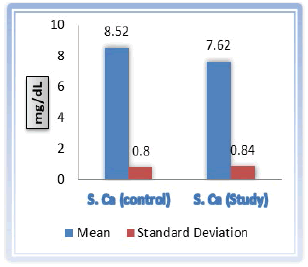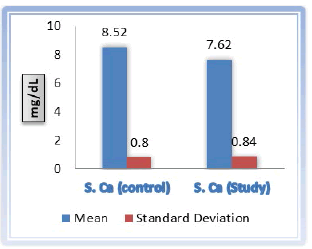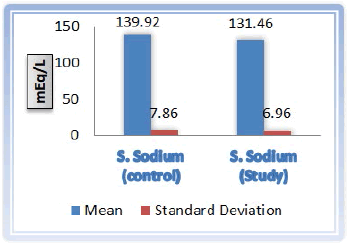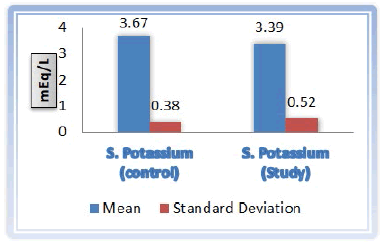Research - International Journal of Medical Research & Health Sciences ( 2022) Volume 11, Issue 6
Comparison of Serum Calcium, Serum Magnesium and Serum Electrolytes in Patients of Preeclampsia and Normal Pregnant Women-A Cross Sectional Study
2Department of Biochemistry, Banas Medical College, Palanpur, Gujarat, India
3Department of Biochemistry, GCS Medical College Ahmedabad, Gujarat, India
Anil Gamit, Department of Biochemistry, GMERS Medical College, Valsad, Gujarat, India, Email: gamit.anil@gmail.com
Received: 16-Feb-2022, Manuscript No. ijmrhs-22-54637; Editor assigned: 17-Feb-2022, Pre QC No. ijmrhs-22-54637 (PQ); Reviewed: 02-Apr-2022, QC No. ijmrhs-22-54637 (Q); Revised: 02-Jun-2022, Manuscript No. ijmrhs-22-54637 (R); Published: 30-Jun-2022
Abstract
Background: Preeclampsia is clinically defined by hypertension and proteinuria, with or without pathological edema. Preeclampsia is a multisystem disorder that complicates about 4%-18% of pregnancies in developing nations and constitutes a major source of morbidity and mortality worldwide. Preeclampsia may be life-threatening for both mother and child, increasing both fetal and maternal morbidity and mortality. About 10%-15% of maternal deaths are directly associated with preeclampsia. Objective: To compare the changes in the level of serum calcium, serum magnesium, and serum electrolytes in patients with preeclampsia and normal pregnant women. Material and Method: Serum calcium, serum magnesium, and serum electrolytes were estimated in 50 cases of preeclampsia and 50 controls of normal pregnant women. 5 ml of blood was collected with clot activator vaccutte and assayed on Micro lab Rx- 50V Biochemistry Analyzer. Result: The levels of serum calcium, serum magnesium, and serum electrolytes are found to be decreased in pre-eclamptic patients (p<0.001) as compared to normal pregnant women. Serum calcium levels were found to decrease in pre-eclamptic patients (7.624 ± 0.84) as compared to normal pregnant women (8.52 ± 0.80). Serum magnesium levels were found to decrease in pre-eclamptic patients (1.47 ± 0.25) as compared to normal pregnant women (1.79 ± 0.18). Serum sodium levels were found to decrease in pre-eclamptic patients (131.46 ± 6.96) as compared to normal pregnant women (139.92 ± 7.86). Serum potassium levels were found to decrease in preeclamptic patients (3.39 ± 0.52) as compared to normal pregnant women (3.67 ± 0.38). Conclusion: We concluded that the levels of serum calcium, serum magnesium, and serum electrolytes were decreased significantly in patients with preeclampsia (p<0.001). Results also prove that these biomarkers can be used as important parameters for the diagnosis of preeclampsiaa.
Keywords
Preeclampsia, Serum calcium, Serum magnesium, Serum sodium, Serum potassium
Introduction
Preeclampsia is a multisystem disorder and a major cause of morbidity and mortality worldwide [1]. In developing nations, the incidence of the disease has been reported as 4%-18% with hypertensive disorders being the second most common obstetric cause of stillbirths and early neonatal deaths [2]. 10%-15% of maternal deaths are directly associated with preeclampsia and eclampsia [3]. The pathophysiology of preeclampsia remains uncertain after much research. Several etiologies have been implicated in the development of preeclampsia, these include abnormal trophoblast invasion of uterine blood vessels, immunological intolerance between fetoplacental and maternal tissues, maladaptation to the cardiovascular changes, dietary deficiencies, and genetic abnormalities [4]. There are numerous risk factors including genetic risk factors, family history of preeclampsia, immunologic factors, nulliparity, a new partner, and demographic factors such as maternal age >35 years [5].
Preeclampsia is characterized by the development of hypertension, proteinuria, and edema at 20th weeks of gestation and in its most severe form is associated with thrombocytopenia, disseminated intravascular coagulation, and hepatocellular damage [6]. Calcium plays a critical role in the function of the cardiac and vascular smooth muscles. The deficiency manifestations of calcium like bleeding diathesis, capillary hemorrhages, and tissue exudation have a resemblance to the clinical manifestations and pathological findings in preeclampsia. Pregnancy is a state of magnesium depletion. The total and ionized magnesium levels are significantly lower in normal pregnancy compared to nonpregnant women. The levels tend to fall during pregnancy and a further decrease in women who develop preeclampsia later [7,8]. The concentration of magnesium during pregnancy exceeds the intake creating a state of physiological hypomagnesemia [9]. Preeclampsia is associated with increased lipid peroxidation and decreased antioxidant enzyme activities. Increased superoxide generation and decreased superoxide dismutase activity and mRNA expression have been observed in placental trophoblast cells [10].
Alteration in the transport of sodium across the cell membrane leads to the accumulation in the extravascular spaces and a decrease in the plasma sodium levels. The serum sodium levels tend to decline in cases of preeclampsia as the disorder increases in severity [11]. Potassium may decrease vascular responsiveness to norepinephrine and enhance the release of NO by the endothelial cells [12,13]. The latter induces vasodilatation and decreases platelet aggregation, which could both decrease blood pressure and protect against hypertension-induced endothelial injury, all of which are responsible for the pathogenesis of symptoms of preeclampsia [14].
Materials and Methods
In this cross-sectional study, 50 cases of preeclampsia and 50 controls of normal pregnant women were selected from the civil hospital and GMERS Medical College, Valsad, Gujarat. The study is conducted from Aug 2020 to Jan 2021. All patients were primarily evaluated by clinical examination.
For serum calcium, serum magnesium, and serum electrolytes estimation, 5 ml of blood is collected with clot activator vaccutte, and samples are transported to the laboratory at (2°C-8°C) within half an hour. The serum is removed from the clot within 2 hours of draw.
All samples are immediately subjected to assays after thawing at 37°C. The measurement of serum calcium, serum magnesium, and serum electrolyte levels are assayed on Micro lab Rx-50V Biochemistry Analyzer.
Results
The present study was done at Civil Hospital, Valsad. Patients with preeclampsia (50 cases) and normal pregnant women (50 controls) were included in the study. Blood samples were collected at the time of admission and were tested for serum calcium, serum magnesium, and serum electrolyte on Micro lab Rx-50V Biochemistry Analyzer (Table 1, Figure 1, Figure 2, Figure 3, and Figure 4). Data analysis was done by using t-test.
| Parameters | Biological Reference Interval | Control group (n=50) | Study group (n=50) | Significance | ||||
|---|---|---|---|---|---|---|---|---|
| Min | Max | Mean ± SD | Min | Max | Mean ± SD | |||
| Calcium | 8.4-10.4 mg/dL | 6.6 | 10.1 | 8.52 ± 0.80 | 5.98 | 9.56 | 7.624 ± 0.84 | t=5.458, **p<0.001 |
| Magnesium | 1.6- 3.0 mg/dL | 1.32 | 2.2 | 1.79 ± 0.18 | 1.01 | 2.1 | 1.47 ± 0.25 | t=7.244, **p<0.001 |
| Sodium | 136-145 mEq/L | 128.1 | 167 | 139.92 ± 7.86 | 118.1 | 148.2 | 131.46 ± 6.96 | t=5.696, **p<0.001 |
| Potassium | 3.5-5.1 mEq/L | 2.87 | 5.06 | 3.67 ± 0.38 | 2.21 | 4.45 | 3.39 ± 0.52 | t=3.023 , **p<0.001 |
| Note: * p<0.05=Significant, **p<0.01=Highly significant, p>0.05=Not significant | ||||||||
As per Table 2, both the cases and controls were age-matched. The mean age (± SD) in cases was 29.42 ± 4.82 years and in controls was 29.28 ± 4.27 years. There was no statistically significant difference in the mean age of both groups (p=0.8781).
| Age groups (years) | Cases (N=50) | Controls (N=50) | ||
|---|---|---|---|---|
| No. | % | No. | % | |
| 20-25 | 8 | 16 | 11 | 22 |
| 26-30 | 15 | 30 | 13 | 26 |
| 31-35 | 12 | 24 | 13 | 26 |
| 36-40 | 13 | 26 | 10 | 20 |
| 41-45 | 2 | 4 | 3 | 6 |
| Total | 50 | 100 | 50 | 100 |
| Mean age (years) ± SD | 29.42 ± 4.82 | 29.28 ± 4.27 | ||
| SD: Standard Deviation, p=0.8781 | ||||
Discussion
There are numerous risk factors including genetic risk factors, family history of preeclampsia, immunologic factors, nulliparity, a new partner, and demographic factors such as maternal age >35 years. Women over 35 years old (Advanced Maternal Age (AMA)) have a 4-5 fold risk of suffering preeclampsia compared to women aged 25-29 years. AMA was considered an independent risk for poor outcomes in preeclampsia patients [5].
The present study was undertaken to know the status of serum calcium, serum magnesium, and serum electrolytes levels in pre-eclamptic women. This study demonstrated a significant decrease in serum calcium, serum magnesium, serum sodium, and serum potassium in pre-eclamptic patients as compared to normal pregnant women. Many clinical studies have shown the relationship between the aggravation of hypertension and the change in maternal serum level of various minerals during pregnancy [15]. Preeclampsia in developing countries has been found to have a great impact because the diet of pregnant mothers is not rich enough in essential minerals and vitamins [16]. Inadequate dietary intake is harmful to the mother and the growing fetus.
In the present study serum, calcium levels were found to decrease in pre-eclamptic patients (7.624 ± 0.84) as compared to normal pregnant women (8.52 ± 0.80). Results of the present study correlated well with the previous studies done by Manjareeka M, et al. and Moholkar AP, et al. [17,18].
Low calcium intake results in high parathyroid hormone levels and increased membrane permeability which leads to the release of calcium from the mitochondria and entering the cytoplasm, resulting in increased intracellular free calcium levels and decreased serum calcium levels. This triggers smooth muscle contraction and results in vascular constriction and increased blood pressure [16].
In the present study serum, magnesium levels were found to decrease in pre-eclamptic patients (1.47 ± 0.25) as compared to normal pregnant women (1.79 ± 0.18). Results of the present study correlated well with the previous studies done by Zohreh T, et al. and Moholkar AP, et al. [18,19].
Magnesium alters the transport of calcium and its binding to the membrane and organ cells. Magnesium causes peripheral vasodilatation and a fall in blood pressure. Thus, low levels of magnesium predispose to an increase in arterial pressure [6].
Also, preeclampsia is associated with increased lipid peroxidation and decreased antioxidant enzyme activities. Increased superoxide generation and decreased superoxide dismutase activity and mRNA expression have been observed in placental trophoblast cells [10]. Treating pre-eclamptic women with MgSO4 reduces lipid peroxidation. MgSO4 protects red cell ghosts and syncytiotrophoblast plasma membranes against lipid peroxidation [20].
In the present study serum, sodium levels were found to decrease in pre-eclamptic patients (131.46 ± 6.96) as compared to normal pregnant women (139.92 ± 7.86). Results of the present study correlated well with the previous study done by Indumati, et al. [21].
Sodium transport is altered across the cell membrane and this leads to the accumulation of sodium in the extravascular spaces and a decrease in the plasma sodium levels. The serum sodium levels tend to decline in cases of preeclampsia as the disorder increases in severity [11].
In the present study serum, potassium levels were found to decrease in pre-eclamptic patients (3.39 ± 0.52) as compared to normal pregnant women (3.67 ± 0.38). Results of the present study correlated well with the previous study done by Manjareeka M, et al. [17].
Potassium decreases vascular responsiveness to vasopressors, like norepinephrine. Leads to vasodilatation and decreases platelet aggregation, which could both decrease blood pressure and protect against hypertension-induced endothelial injury, all of which are responsible for the pathogenesis of symptoms of preeclampsia.
Conclusion
The present study aimed to measure the levels of HS-CRP, uric acid, calcium, magnesium, and electrolytes in patients with preeclampsia and to evaluate whether these parameters can be used as diagnostic markers of preeclampsia. The levels of serum calcium, serum magnesium, and serum electrolytes were decreased significantly in patients with preeclampsia (p<0.001). Results also prove that these biomarkers can be used as diagnostic markers of preeclampsia.
Declarations
Conflict of Interest
The author(s) declared no potential conflicts of interest with respect to the research, authorship, and/or publication of this article.
References
- Kumar, Vinay. "Cellular adaptation, cell injury, and cell death in: Robins and Contran pathologic Basis of Disease. Vinay Kumar, Ardul, K. Abbas, Nelson Fausto." Elsevier Saunders, 1999, pp. 3-46.
Google Scholar - Rifai, Nader. "Tietz textbook of clinical chemistry and molecular diagnostics-e-book." Elsevier Health Sciences, 2017.
Google Scholar - Du Clos, Terry W. "The interaction of C-reactive protein and serum amyloid P component with nuclear antigens." Molecular Biology Reports, Vol. 23, No. 3, 1996, pp. 253-60.
Google Scholar Crossref - Semczuk, Marian, and Anna Semczuk-Sikora. "New data on toxic metal intoxication (Cd, Pb, and Hg in particular) and Mg status during pregnancy." Medical Science Monitor: International Medical Journal of Experimental and Clinical Research, Vol. 7, No. 2, 2001, pp. 332-40.
Google Scholar - Barton, John R., and Baha M. Sibai. "Prediction and prevention of recurrent preeclampsia." Obstetrics & Gynecology, Vol. 112, No. 2, 2008, pp. 359-72.
Google Scholar Crossref - Powers, Robert W., et al. "Uric acid concentrations in early pregnancy among preeclamptic women with gestational hyperuricemia at delivery." American Journal of Obstetrics and Gynecology, Vol. 194, No. 1, 2006, pp.160e1-e8.
Google Scholar Crossref - Bardicef, Mordechai, et al. "Extracellular and intracellular magnesium depletion in pregnancy and gestational diabetes." American Journal of Obstetrics and Gynecology, Vol. 172, No. 3, 1995, pp. 1009-13.
Google Scholar Crossref - Sibai, Baha M. "Diagnosis, prevention, and management of eclampsia." Obstetrics & Gynecology, Vol. 105, No. 2, 2005, pp. 402-10.
Google Scholar Crossref - Romani, Andrea MP. "Magnesium in health and disease." Interrelations between Essential Metal Ions and Human Diseases, 2013, pp. 49-79.
Google Scholar - Johnson, Richard J., et al. "Is there a pathogenetic role for uric acid in hypertension and cardiovascular and renal disease?" Hypertension, Vol. 41, No. 6, 2003, pp. 1183-90.
Google Scholar Crossref - Roberts, James M. "Endothelial dysfunction in preeclampsia." Seminars in Reproductive Endocrinology. Vol. 16. No. 1, 1998.
Google Scholar - Belizan, JoseM, Jose Villar, and John Repke. "The relationship between calcium intake and pregnancy-induced hypertension: Up-to-date evidence." American Journal of Obstetrics and Gynecology, Vol. 158, No. 4, 1988, pp. 898-902.
Google Scholar Crossref - Smith, Gordon CS, Jill P. Pell, and David Walsh. "Pregnancy complications and maternal risk of ischaemic heart disease: A retrospective cohort study of 129 290 births." The Lancet, Vol. 357, No. 9273, 2001, pp. 2002-06.
Google Scholar Crossref - Tan, Sidhartha, et al. "Circulating xanthine oxidase in human ischemia reperfusion." Southern Medical Journal, Vol. 88, No. 4, 1995, pp. 479-82.
Google Scholar Crossref - Haddad, Bassam, et al. "Are perinatal and maternal outcomes different during expectant management of severe preeclampsia in the presence of intrauterine growth restriction?" American Journal of Obstetrics and Gynecology, Vol. 196, No. 3, 2007, pp. 237e1-e5.
Google Scholar Crossref - Pikilidou, Maria I., et al. "Blood pressure and serum potassium levels in hypertensive patients receiving or not receiving antihypertensive treatment." Clinical and Experimental Hypertension, Vol. 29, No. 8, 2007, pp. 563-73.
Google Scholar Crossref - Manjareeka, M., and Sitikantha Nanda. "Serum electrolyte levels in preeclamptic women: A comparative study." International Journal of Pharma and Bio Sciences, Vol. 3, No. 2, 2012, pp. 572-78.
Google Scholar - Moholkar, A. P., et al. "Serum calcium and magnesium levels in preeclampsia." International Journal of Pharmacy and Biological Sciences, Vol. 4, No. 3, 2014, pp. 42-45.
Google Scholar - Asemi, Zatollah, et al. "Vitamin D supplementation affects serum high-sensitivity C-reactive protein, insulin resistance, and biomarkers of oxidative stress in pregnant women." The Journal of Nutrition, Vol. 143, No. 9, 2013, pp. 1432-38.
Google Scholar Crossref - Abad, C., et al. "Magnesium sulfate affords protection against oxidative damage during severe preeclampsia." Placenta, Vol. 36, No. 2, 2015, pp. 179-85.
Google Scholar Crossref - Indumati, V., M. V. Kodliwadmath, and M. K. Sheela. "The role of serum electrolytes in pregnancy induced hypertension." Journal of Clinical and Diagnostic Research, Vol. 5, No. 1, 2011, pp. 66-69.
Google Scholar




